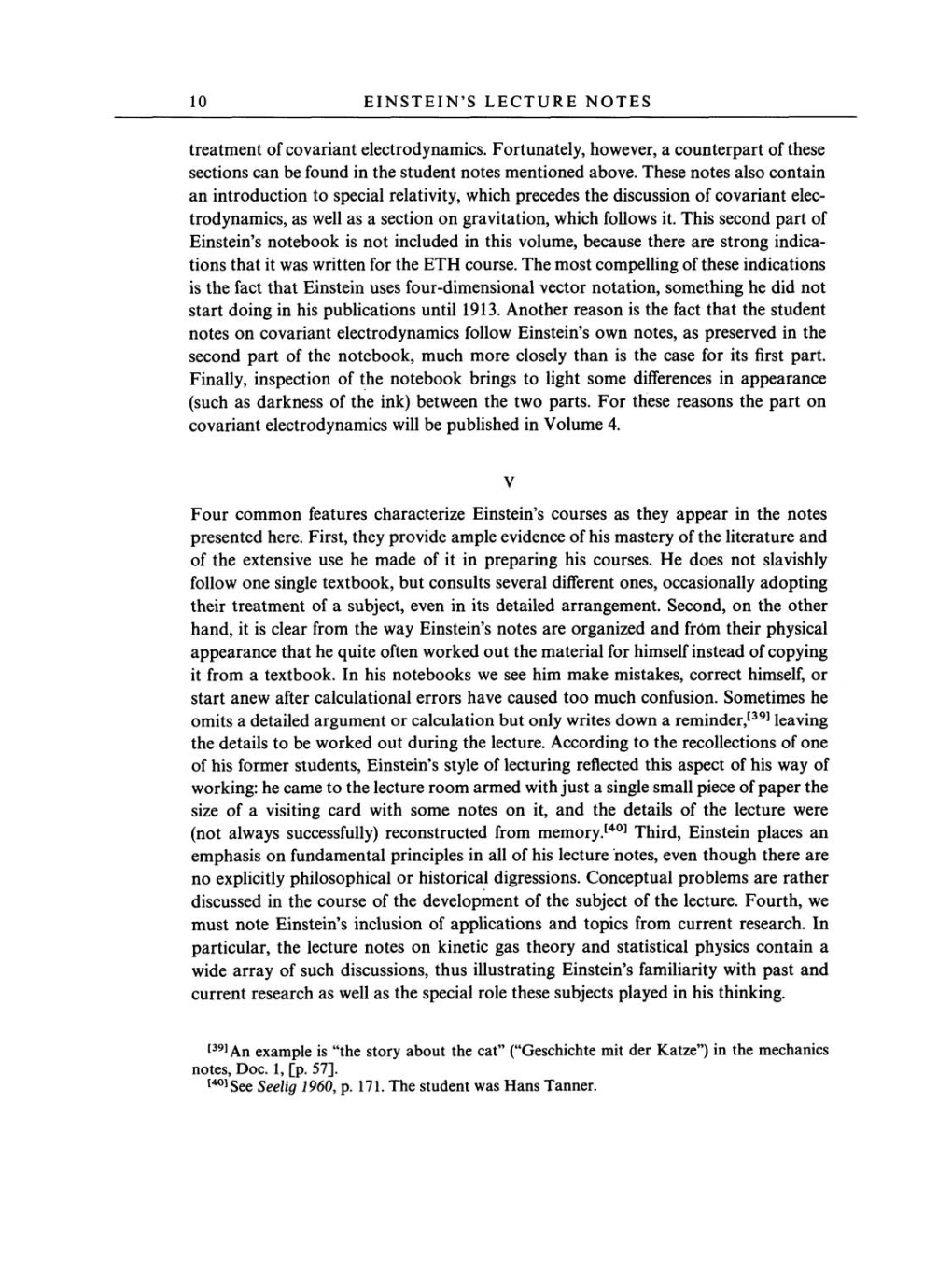10
EINSTEIN'S
LECTURE
NOTES
treatment
of covariant
electrodynamics. Fortunately,
however,
a
counterpart
of
these
sections
can
be
found
in
the student
notes
mentioned above. These
notes
also contain
an
introduction
to
special relativity,
which
precedes
the discussion of covariant
elec-
trodynamics,
as
well
as a
section
on
gravitation,
which follows
it.
This second
part
of
Einstein's notebook
is not
included
in
this
volume,
because there
are
strong
indica-
tions
that
it
was
written for the ETH
course.
The
most
compelling
of
these
indications
is
the fact
that
Einstein
uses
four-dimensional
vector notation,
something
he did
not
start
doing
in his
publications
until
1913.
Another
reason
is
the
fact
that
the
student
notes
on
covariant
electrodynamics
follow Einstein's
own
notes,
as
preserved
in
the
second
part
of the
notebook,
much
more closely
than
is
the
case
for its
first
part.
Finally, inspection
of the notebook
brings
to
light
some
differences in
appearance
(such as
darkness of the
ink)
between the two
parts.
For these
reasons
the
part
on
covariant
electrodynamics
will
be
published
in
Volume
4.
V
Four
common
features characterize Einstein's
courses as
they appear
in
the
notes
presented
here.
First, they provide ample
evidence of
his
mastery
of
the
literature and
of
the
extensive
use
he
made of
it in
preparing
his
courses.
He does
not
slavishly
follow
one single
textbook,
but consults several different
ones,
occasionally adopting
their
treatment
of
a
subject,
even
in its detailed
arrangement. Second,
on
the other
hand, it
is
clear
from
the
way
Einstein's notes
are
organized
and from their
physical
appearance
that
he
quite
often worked
out
the material for himself instead of
copying
it
from
a
textbook.
In
his
notebooks
we see
him make
mistakes,
correct
himself, or
start
anew
after
calculational
errors
have caused
too
much confusion. Sometimes
he
omits
a
detailed
argument
or
calculation but
only
writes down
a
reminder,[39] leaving
the details
to be
worked
out
during
the lecture.
According
to
the recollections of
one
of
his
former
students,
Einstein's
style
of
lecturing
reflected
this
aspect
of
his way
of
working:
he
came
to
the
lecture
room
armed with
just
a single
small
piece
of
paper
the
size
of
a
visiting
card with
some
notes
on
it,
and the details of the lecture
were
(not always
successfully)
reconstructed from
memory.[40]
Third,
Einstein
places
an
emphasis
on
fundamental
principles
in
all
of
his
lecture
notes,
even
though
there
are
no
explicitly philosophical or
historical
digressions. Conceptual
problems are
rather
discussed
in
the
course
of the
development
of the
subject
of
the lecture.
Fourth,
we
must note
Einstein's inclusion of
applications
and
topics
from
current
research. In
particular,
the lecture
notes
on
kinetic
gas theory
and statistical
physics
contain
a
wide
array
of such
discussions,
thus
illustrating
Einstein's
familiarity
with
past
and
current
research
as
well
as
the
special
role these
subjects played
in
his
thinking.
[39]
An example
is
"the
story
about the cat"
("Geschichte
mit der
Katze")
in
the mechanics
notes,
Doc.
1,
[p.
57].
[40] See
Seelig 1960, p.
171.
The student
was
Hans Tanner.
